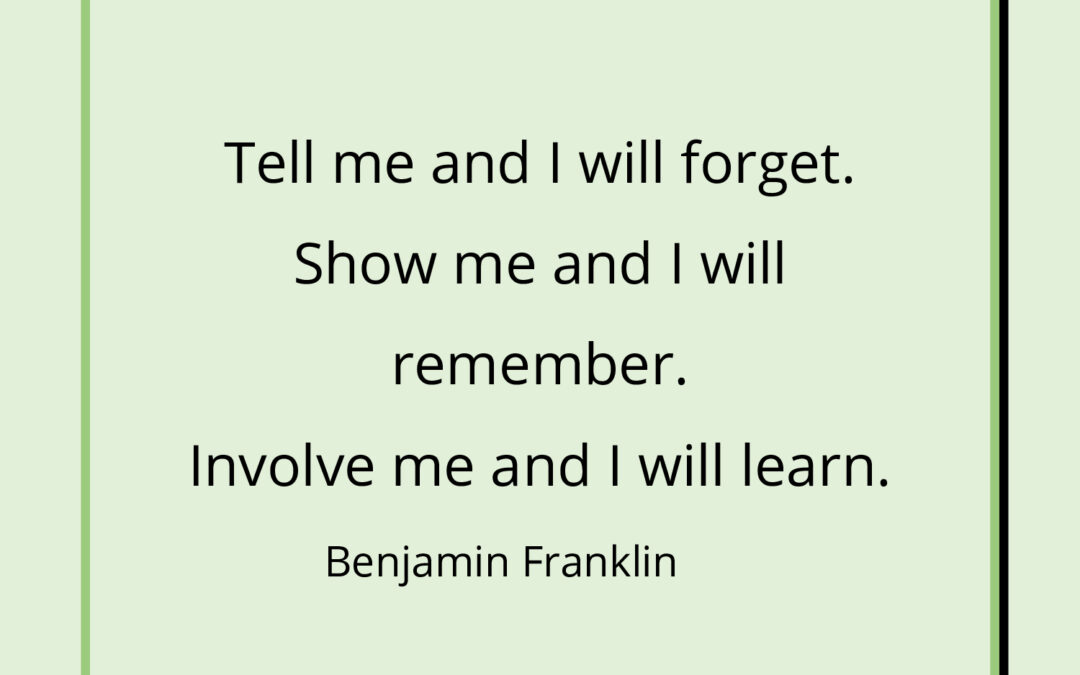
Parenting a right brain kinesthetic learner can be rewarding and incredibly frustrating. We lived through years of frustration, before we realized our daughter was a right brain kinesthetic learner who could do far better with a hands-on and engaging learning process I developed. We have helped thousands of other right brain kinesthetic learners to be far more successful than even their parents thought possible. Our assessment process is designed to both identify your child’s learning style, their strengths and their challenges and their present level of performance – especially for reading fluency and reading comprehension. After our assessment, we then discuss with parents their child’s unique profile, and what we think is possible with a tailored program for your child.
We start with four key thoughts:
- Probably 75 to 85 percent of the smart struggling students are a right brain kinesthetic learner who can do far better when they are taught to their strengths
- Too often assessments focus on one area or the student’s challenges. We have found there is tremendous value in identifying the right brain kinesthetic learner and in identifying whether they have a visual processing issue, executive function issues and/or dyslexia. We also know that reading fluency is used as a barometer of reading skill. We believe it is critical to assess for both reading fluency and reading comprehension.
- Informed, empowered and proactive parents can and often do make the difference.
- Comprehensive assessment can help you understand your child’s strengths, challenges and how you can make the difference.
Note, the 3D Learner Assessment can be completed live in either our Coral Springs, Florida, or Durham, NC locations or via zoom.
If you would like to discuss your specific situation and whether your child might be a right brain kinesthetic learner, you can either:
– Call us at 561-361-7495 or click on
– Schedule a conversation to find a mutually agreeable time
Most of our students are bright right brain kinesthetic learners, who learn best when they see and experience information. These students often:
- Are a lot smarter than present results would indicate
- Benefit from special education and tutoring, which are both helpful, but rarely help the student to reach his or her full potential
- Have some combination of visual processing, auditory processing and/or executive function challenges
- Have dyslexia, but not always. About 33% of our students have dyslexia.
- Can make far greater progress within months if their parents invest in a program that:
- Leverages their strengths and engages them
- Identifies and addresses their challenges
- Has a clear understanding of the present level of performance on key items.
- Is tailored for their child. Every child is unique, and their learning style plays a crucial role in shaping their educational journey. Among the different learning styles, right brain kinesthetic learners stand out as individuals who absorb information best through hands-on experiences and visual aids. In this article, we’ll explore why it’s essential to assess the strengths and challenges of right brain kinesthetic learners, particularly concerning visual processing issues, executive function issues, and dyslexia. By understanding their learning profile, we can design a tailored program that nurtures their abilities for a successful learning experience.
Unraveling the Right Brain Kinesthetic Learner
The right brain kinesthetic learner is characterized by a preference for tactile experiences, physical movement, and visual learning. These learners thrive in an interactive environment, where they can touch, explore, and manipulate objects to understand concepts better. Identifying this learning style ASAP can significantly impact a child’s educational progress. Note, we did not get it right until 11th grade. It did help our daughter to improve her reading comprehension 4.2 grade levels in 7 months and improve her GPA from a 2.7 to a 4.4. Note, the earlier the better, but it is never too late.
The Power of Assessing Strengths
Assessing a right brain kinesthetic learner’s strengths is the first step toward unlocking their potential. You want to identify areas where the child excels. Whether it’s artistic abilities, strong spatial awareness, or exceptional hand-eye coordination, recognizing these strengths can pave the way for a personalized learning approach. The questions we ask and the Structure of Intellect Assessment ® we use helps us to identify how your child learns best. A Boca Raton Principal commented, “I really liked the Structure of Intellect Assessment; why did we stop using it?”. Her special education specialist said that the government requires us to label a child and the SOI Assessment does not label a child. The SOI helps to tailor a program to meet the child’s needs, which is why 3D Learner uses it.
Understanding Visual Processing Issues
Visual processing issues can affect a right brain kinesthetic learner’s ability to comprehend visual information efficiently. These learners may struggle with tasks that involve reading, interpreting diagrams, or following instructions with visual cues. Identifying and addressing visual processing challenges early can lead to targeted interventions and improved learning outcomes. We use a Visagraph to show how a student’s eyes track. Here is a video that shows a student’s tracking before and after our program. We find a significant visual processing issue in close to 70 percent of our students.
Navigating Executive Function Issues
Executive function issues can pose additional obstacles for right brain kinesthetic learners. These cognitive processes are responsible for organization, time management, and impulse control. When executive functions are weak, students may face difficulties in planning, initiating tasks, and staying focused. Implementing strategies to bolster executive functions can support the learner in managing academic responsibilities effectively. Note, we use the Mindprint Assessment ® developed by the University of Pennsylvania to assess Executive Function Skills for students reading at the 2nd grade level or higher. We also use the Interactive Metronome ® to assess for attention. This is an excellent tool to show an attention issue, and it is very effective at improving attention.
The Impact of Dyslexia
Dyslexia is a learning disability that affects reading and language processing. For right brain kinesthetic learners with dyslexia, traditional reading approaches may not yield the desired results. Recognizing the presence of dyslexia is vital for providing appropriate accommodations, such as alternative reading methods, assistive technologies, and specialized tutoring. We use the CORE Assessment, which is part of the University of Florida’s UFLI Program ® we are certified to provide.
Designing a Program for Success
By acknowledging the strengths, visual processing issues, executive function issues, and dyslexia in a right brain kinesthetic learner, parents and educators can design a comprehensive program tailored to their specific needs. Here are some strategies to consider:
- Incorporate hands-on activities and visual aids into lessons to enhance learning engagement.
- Use technology and interactive learning tools to support comprehension and retention.
- Provide a structured and organized learning environment to address executive function challenges.
- Seek support from educators, specialists, and support groups to develop targeted interventions for dyslexia.
The Value of Assessing for Success
Recognizing and understanding the learning style of a right brain kinesthetic learner is crucial for their educational success. By assessing their strengths, visual processing issues, executive function issues, and dyslexia, parents and our team can create a personalized program that nurtures their unique abilities and helps overcome challenges. Through a tailored approach, we can empower your child to thrive academically and develop a lifelong love for learning.
Note, the 3D Learner Assessment can be done live in either our Coral Springs, Florida, or Durham, NC locations or done via zoom.
If you would like to discuss your specific situation and whether your child might be a right brain kinesthetic learner, you can either:
– Call us at 561-361-7495 or click on
– Schedule a conversation to find a mutually agreeable time
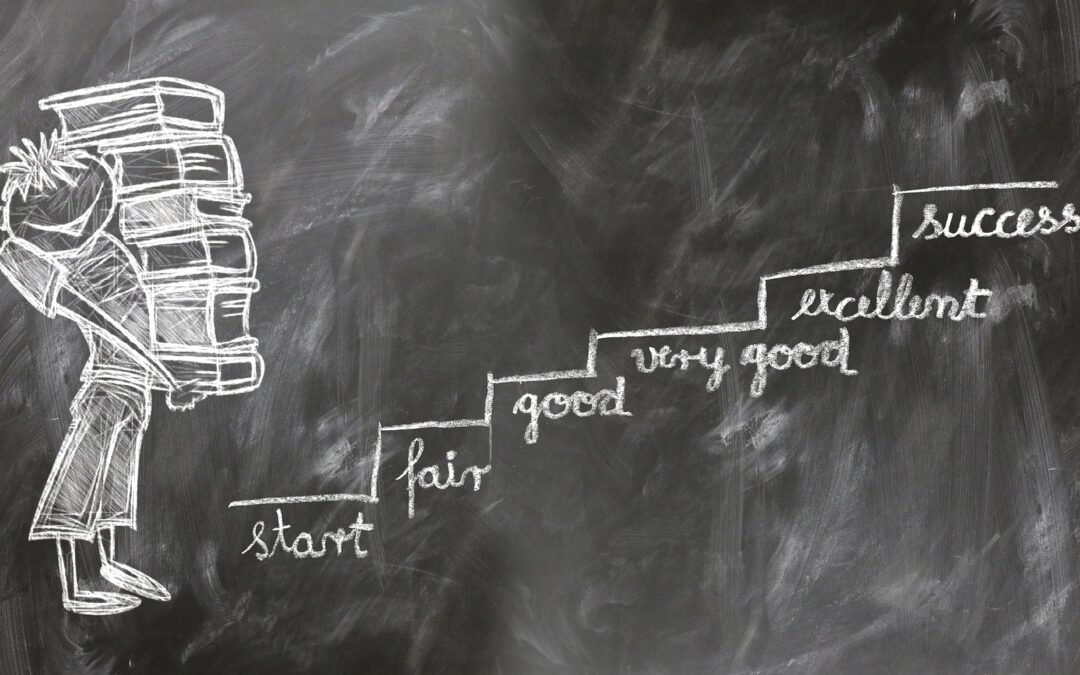
(Strength based training and strength based parenting works for these students)
We focus on how parents can take charge and help your right brain kinesthetic learner succeed. Note, most smart struggling students are right brain kinesthetic learners, who learn best when they see and experience information. When we were told our 8th grade daughter was not college material, I became a mom on a mission. I leveraged my educational and parenting skills and developed what has become the 3D Learner Program ®. With the program, she was able to improve:
- Her reading comprehension 4.2 grade levels in 7 months
- Her Grade Point Average from a 2.7 to a 4.4
- Chances for success. She got her Master’s in Education from the University of Florida. Next year will be her 19th year of teaching and in May 2024 she should be receiving her Doctorate in Education from the University of Florida.
Many of our students are bright right brain kinesthetic learners, who often struggle with:
- Reading comprehension — just this year we have had 6th and 7th graders who were 3, 4 and even 5 years below grade level
- Reading speed — too often students read so slowly that it is hard to sustain attention
- Math word problems
- Putting their thoughts on paper
- Being in classes with kids who are not motivated
For the purposes of this blog post, we will define success for these students as:
- Being on grade level for reading speed
- Reading comprehension two, three or four grade levels higher than their present level
- Being able to get a B or better in math, learn how to check their work and start to like math
- Both mastering math facts and being good at math word problems
- Writing at least at grade level
- Being able to do their homework more independently in much less time
- Now being placed in advanced or gifted classes, where they are far more engaged
- Being proud of their success
Here is a classic case:
The parents had invested $34000 in a competitors’ program and their 5th grade daughter’s reading comprehension was at the 1st grade level, she was a slow reader, and her homework was taking 2.5 hours or longer. She came across an article that asked
- Does your child remember places visited, even from years ago?
- Does your child learn best when he or she sees and experiences information?
- Is your child a lot smarter than her present level of reading comprehension would indicate?
The mom was an action taker. She called us from Texas and wanted to know more. We did a remote assessment that showed her reading comprehension was at the 1st grade level, her reading speed was 115 words per minute and she was a right brain kinesthetic learner. Her parents brought her to Florida for an intensive week of training.
6 months later, she had improved as follows:
- Her reading comprehension was now at the 5th grade level
- Her reading speed was 229 words per minute, virtually doubling where it had been
- Homework time had decreased from 2.5 hours to 1.25 hours and her mother’s time helping her had decreased from 2.5 hours to 15 minutes
- She was now doing well in school and was being recommended for some advance classes in 6th grade — where she did very well
Note, in 2023 we had had many local successes and we had had successes with students from the State of Washington and Arizona.
If you would like to discuss how to put your child on their
Pathway to Success, call us at 561-361-7495
What Are The Common Strengths and Challenges for The Smart Struggling Student
The bright right brain kinesthetic learner often has 3, 4 or 5 of the following strengths and challenges
They often:
- Learn differently and are right brain kinesthetic learners
- Have auditory and/or visual processing issues
- Have one or more executive function challenges (attention, working memory and/or processing speed)
- Have a learning disability or dyslexia
- Are frustrated and/or anxious
Note, the strengths of the right brain kinesthetic learner are rarely identified or capitalized on.
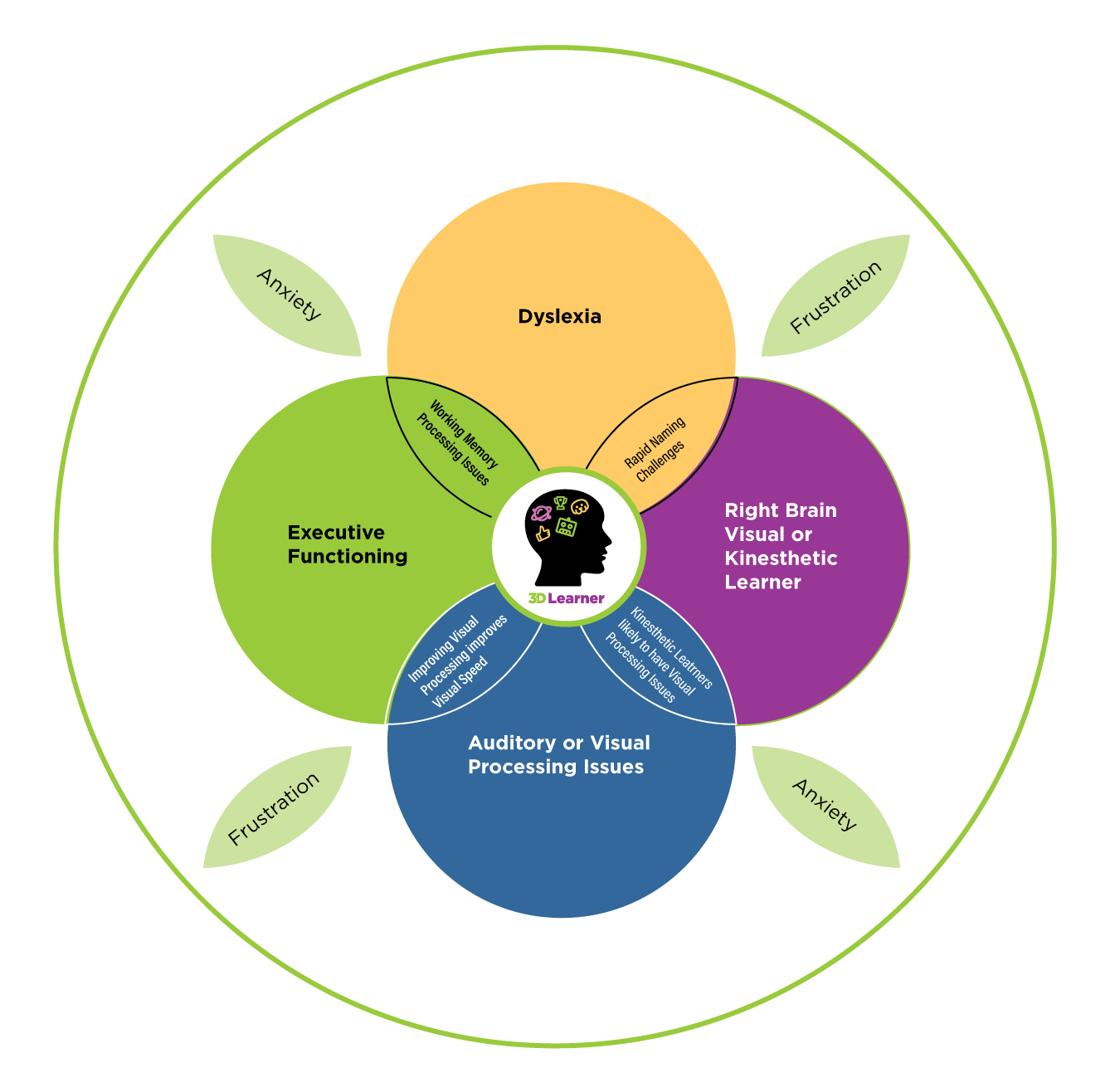
Bright Right Brain Kinesthetic Learners Benefit When One Capitalizes on Their Strengths,
while Identifying and Addressing the Relevant Issues
This Often Requires The Parents to Take Charge
Is your child a bright right brain kinesthetic learner?
- Does your child remember places visited, even from years ago?
- Does your child learn best when he or she sees and experiences information?
- Is your child a lot smarter than present results would indicate?
For a more comprehensive screening tool, download our “Is my child a right brain kinesthetic learner”.
If your child is a right brain kinesthetic learner, you play a pivotal role. Too many of these kids are identified by their challenges. These could include dyslexia, executive function issues, auditory or visual processing and/or anxiety and frustration. We have been there with two of our four kids. Over the last 26 years we have helped thousands of kids like this succeed with a process that starts by helping parents to be an informed, empowered and proactive parent.
We FRAME this differently than most. Specifically:
– Frustration comes with the territory. We encourage you to embrace the frustration and to commit to helping your child to be all they can be. If your child is a right brain kinesthetic learner, there is a good chance that when you leverage their strengths, identify and address their challenges, and leverage their desire to succeed, success is much more likely to follow.
– Reject the status quo and low expectations. Too often we have heard, parents being told that one cannot expect significant gains within a year. Two key points:
- We are seeing many kids whose reading comprehension is far below grade level. This chart shows how often students in special education fall far below grade level
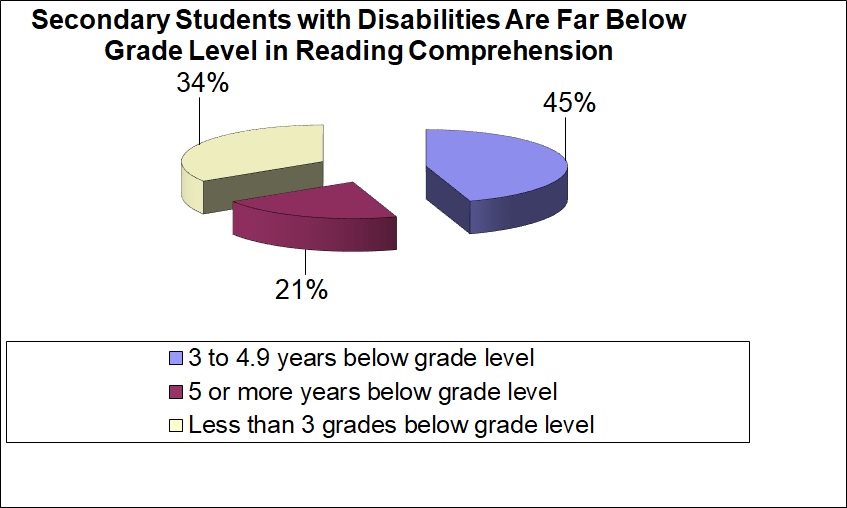
- Improving reading comprehension by 2, 3 or even 4 grade levels within 4 to 6 months is often possible. A few words of caution:
- Such results take both a commitment to training and follow-up
- Students with lower IQs and/or significant impairments may not make these gains
- Cooperation and collaboration help
Waiting is Not an Option
The next critical step is to:
Assess for Success. This would include assessing for:
- How your child learns best
- Executive function issues (e.g. working memory, processing speed and attention)
- Auditory and visual processing issues.
- Dyslexia or another learning disability
- Your child’s present level of reading fluency and reading comprehension
If the assessment shows considerable upside potential, we recommend you adopt the
Mindset that Success is the Only Option. Then you consider
- Enrolling the services of the right professional for your child and you. Ideally, you want to work with professionals who will:
- Leverage your child’s strengths
- Address their challenges
- Boost their confidence and resilience
- Help you to be the coach and advocate your child needs
- Produce excellent results within months
If you would like to discuss how to put your child on their
Pathway to Success, call us at 561-361-7495
Feel free to share with others, who have a smart struggling child with significant upside potential.
Note, next week we will have our second article on Helping Your Bright Right Brain Kinesthetic Learner succeed in 4th grade and above. That article will focus on Assessing for Success.

(Call us at 561-361-7495 if you would like to discuss how your child can make significant progress this summer)
70% of our clients contact us to improve their child’s reading comprehension and executive function skills. 30% of our clients want to improve reading comprehension and executive function skills and have a Dyslexia Treatment to improve their child’s reading fluency, too.
As of July 1, we will be entering our 27th year in business. What is really troubling is that more students than anytime in our career are further behind in reading fluency, reading comprehension and math. To make matters worse, more students lack the foundational skills and confidence needed to succeed. Our goal is to help our students to make significant gains in months, to address the relevant academic skills and to identify and address the key foundation skills that are missing. We also strive to reduce anxiety, boost confidence and instill a love for learning.
If you want to have a conversation on Creating a Pathway from Stress to Outrageous Success for your child,
– Call us at 561-361-7495 or
– Find a mutually agreeable time on our schedule by clicking on Let’s Schedule a Conversation.
On Thursday May 4th, we will be hosting a webinar at 8:30 pm on a
Summer Program to Dramatically Improve Reading Fluency, Reading
Comprehension, Executive Function Skills and Confidence.
Click here to register for our Parents make The Difference Webinar
What makes 3D Learner a unique offering:
- We tailor our program to meet the key goals we set with parents. These might include: improving reading comprehension by 2, 3 or even 4 grade levels in 4 to 6 months; improving reading fluency; improving attention, working memory and/or processing speed; addressing visual processing in a way that improves academics and athletic skills: and/or reducing anxiety, building confidence and igniting a love for learning
- Our assessment process evaluates reading fluency, reading comprehension, executive function skills, visual processing, how your child learns best, where your child is strong and where they struggle. We then incorporate a debrief that results in setting goals for the next 4 to 6 months. If you would like, we then provide program options that can address some or all of the relevant issues.
Our process allows us to identify the bright right brain kinesthetic learner, who is often much smarter than present results would indicate. We also provide an in-depth look at how your child’s eyes track when reading; whether your child has an attention, working memory and/or processing speed issue; and to what extent there are issues with decoding, phonemic aware, and reading fluency
 Our process starts with an assessment that identifies: the right brain kinesthetic learner; whether there are a visual processing, working memory, processing speed and/or attention issue; whether dyslexia is present; and your child’s present level of reading comprehension.
Our process starts with an assessment that identifies: the right brain kinesthetic learner; whether there are a visual processing, working memory, processing speed and/or attention issue; whether dyslexia is present; and your child’s present level of reading comprehension.
We also provide parent training that helps you to become even more effective coaches and advocates for your child.
- We use the UFLI Program ® to improve decoding, phonemic awareness and reading fluency, where needed. This program moves at a faster pace than most, but reinforces what the student has learned throughout the process. This is a dyslexia treatment that fits well into our program.
- We target the areas of greatest need. Often this includes some combination of reading comprehension, reading fluency, executive function, visual processing and reducing anxiety, while building confidence. Note, the length of our program depends on your child’s needs and your goals.
It is important to note, that while a number of our students have made considerable gains, these are not possible for all students. We see the most significant gains in the student with above average and even gifted IQs who are performing well below their potential. We strive to be BOLD but realistic when we set goals.
Note, our program was designed for our daughter who was able to improve her reading comprehension 4.2 grade levels in 7 months. Today, our clients are mostly between the ages of 6 and 17.
What delights us is that we can help students to make significant gains. The first place we really make the difference is with our initial conversation. Three examples:
- Mom called with a problem that is impacting many students today. The private school her son attended suggested she find a different school for her son, based on his reading comprehension being 2 years below grade level. She called us and after 10 minutes she commented, “How is it you know my son better than anyone at his school who have known him for 4 years”. She came to us from out of state and her son improved his comprehension 3 grade levels in a year. His teacher said, “Thomas made more progress in a year than any student I have had in 27 years of teaching
- Mom called from the state of Washington. She had been told her son was a right brain visual learner, who learned best when he saw and experienced information. She too was surprised how well we knew her child. Her son was able to improve his reading comprehension 4 grade levels in 7 months and blossom as a student.
- A local mom called us. She heard about us from a friend, where we had helped her friend’s gifted son go from the 58th to the 99th percentile in reading comprehension. Note, he later went to MIT. Mom had a son who was smart, but his reading comprehension was 4 years below grade level. Her challenge was that her son did not realize how smart he was. Our assessment showed that as he was about to enter 9th grade, he was at college level on 9 out of the 26 skills we assessed and only had 4 areas where he was weak. For the first time he saw himself as a smart kid who learned differently. In less than 4 months, he was able to improve his reading comprehension from the 5th to the 9th grade level and increase his reading speed from 200 to 360 words per minute. He went onto get several full college scholarships
All this starts when the parents engaged in a conversation to discover how her child could succeed.
Click here to register for our Parents make The Difference Webinar
If you want to have a conversation on Creating a Pathway from Stress to Outrageous Success for your child,
– Call us at 561-361-7495 or
– Find a mutually agreeable time on our schedule by clicking on Let’s Schedule a Conversation
Our Assessment Special
Complete a Comprehensive Assessment in May and receive the Safe and Sound Protocol ® — ordinarily a $300 investment — that will help your child and you reduce stress and anxiety
.
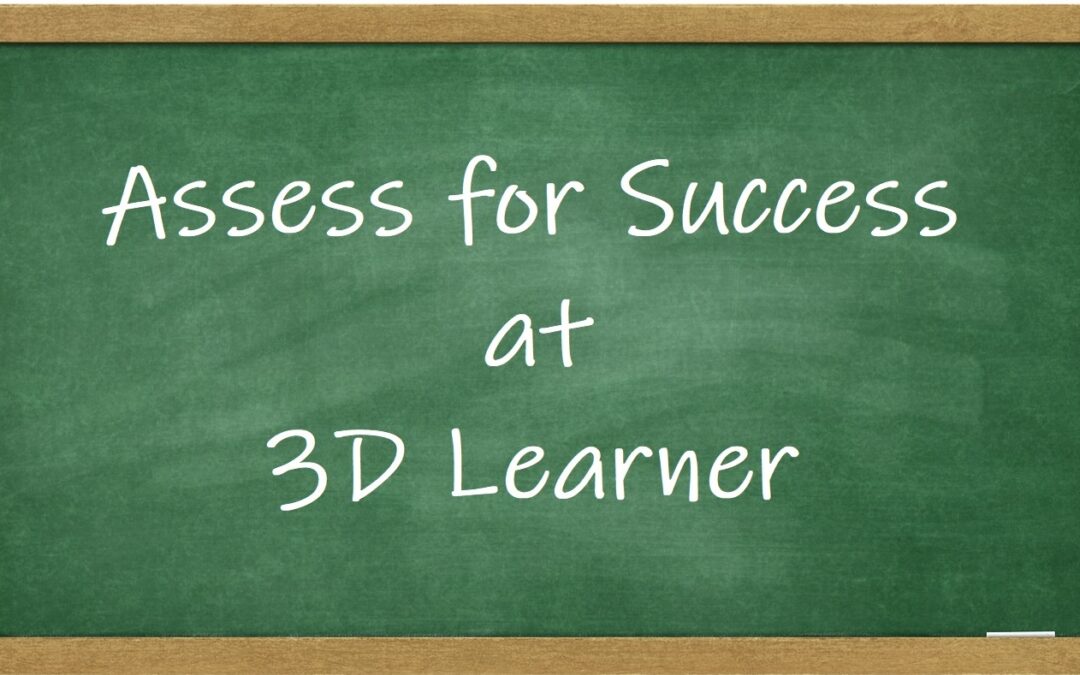
Ask About Our May Assessment Special to reduce anxiety and stress
Over the last two years, we have assessed a number of students and seen seven trends:
- Executive function deficits are the most common problem – these include problems with attention, working memory, processing speed and related skills
- Reading comprehension levels are further below grade level than at any point in our 26 years in assessing students
- Many students lack the language skills needed to succeed
- Visual processing challenges are more common and the issues are often more severe
- Dyslexia is more common and students are often lacking the basic phonics, phonemic awareness and related skills they need to succeed
- More programs than ever are attacking dyslexia, but do not necessarily capitalize on these student’s strengths or address the executive function and visual processing issues.
- Parents want to help but are overwhelmed.
Over the last 26 years, 3D Learner has helped thousands of students succeed with an approach that helps parents see their child’s potential for growth when they:
Reject the status quo and look for solutions that:
-
-
- Identify and capitalize on their child’s strengths
- Identify and address their child’s weaknesses
- Boost their child’s self-esteem and lower their anxiety
- Is tailored to help their child to make significant gains within months
- Helps parents to be even more effective coaches and advocates for their child
We suggest you contact us to start a conversation that allows you to discuss your child’s challenges and gifts and learn how you can make the difference.
Assess for Success. School based assessments are specifically designed to identify or rule out certain conditions (e.g dyslexia, learning disabilities, ADHD, working memory, processing speed etc). Our goals are to identify:
-
-
-
- How a child learns best and where they are strong
- Where they struggle, with a focus on executive function skills, visual processing, language and dyslexia
- Their present level of performance, especially for reading comprehension
- A tailored solution that can help a student make dramatic gains in months
Our Story
We have been there with our own kids. With my daughter, dyslexia was the diagnosis and we tried one dyslexic treatment after another. It improved our daughter’s reading fluency, that is how efficiently and effectively she could read out loud. Unfortunately, she continued to struggle with:
-
-
- Reading comprehension
- Executive function skills — attention, working memory and processing speedAnxiety and frustration – who wouldn’t be frustrated if you were a lot smarter than present results indicated
In 8th grade, we were told our daughter was not college material, because her reading comprehension was 3 years below grade level. I became a mom on a mission. I am Mira Halpert. I have my Master’s in Education and significant educational experience, but I needed a different set of tools.
With the 3D Learner Program ® I developed, my daughter improved her reading comprehension 4.2 grade levels in 7 months. She will soon complete her 19th year of teaching. Next year, she will earn her PHD.
Over the last 26 years, 3D Learner has helped thousands of smart kids succeed.
This includes:
-
-
- A kindergarten student who was really struggling who aced the first grade final the first week of first grade
- A 1st grader who was really struggling who is now going to Emory Univeristy
- A 2nd grader who improved her reading comprehension 2 grade levels in 4 months and 3 grade levels in 7 months, after being stuck for two years
- A 3rd grader who made more progress than any student his teacher had had in 27 years of teaching
- A 4th grader whose parents were told to send him to a school for students with dyslexia who wound up at Harvard
- A 5th grader whose reading comprehension was at the 1st grade level, she read slowly and homework time took forever. She improved her reading comprehension 4.2 grade levels, doubled her reading speed and cut her homework time by 50 percent. She also did it independently
- Middle and high school students who improved their comprehension 3 and even 4 grade levels in 4 months and who dramatically improved their sports skills
Questions for you to consider
Is your child a bright right brain kinesthetic learner?
-
-
- Does your child remember places, even from years ago?
- Does your child learn best when he or she sees and experiences information?
- Is your child a lot smarter than present results would indicate?
If the answers are yes, there is a good chance your child is a right brain kinesthetic learner. Dr. Linda Silverman has developed a 15 question screening tool to identify the right brain kinesthetic learner. Click here to see if your child might be a right brain kinesthetic learner.
Studies have shown that over 60 percent of the students today learn best when they see and experience information. Many of the other students are more logical, sequential and auditory, which is the way schools often teach. As a result, these right brain kinesthetic learners make up a significant percentage of the smart struggling students.
These are the students we do very well with,
The infographic below shows the 5 key attributes of these students. That is they are:
-
-
- Often a right brain kinesthetic learner
- Virtually all of them either have executive function challenges that might include:
- Attention to that which is boring or frustrating
- Working memory – they often have an excellent memory for that which they see and experience and a much weaker memory for that which they hear or read
- Processing speed — like the old 56k modems, they download visuals very slowly
- Visual processing issues are found in over 70 percent of our students. That is they see and experience information.
- Close to 40 percent of our students are struggling with dyslexia and/or learning disabilities
- Anxiety and/or frustration are often present

Since our goal is to tailor a program to improve reading fluency, reading comprehension, executive function, math skills and lower anxiety, we need to assess the whole child.
If you would like to discuss your child’s situation,
a) Call us at 561-361-7495
b) Click here to schedule a zoom meeting:
Assess for Success Conversation
We encourage you to call us to discuss how you can significantly improve your child’s executive function skills, reading comprehension, self-esteem and so much more.

Beating Dyslexia is really hard. This is especially true if your child is a Bright Right Brain Kinesthetic Learner with Dyslexia. Note, it is far easier for these kids to succeed if you:
-
- Address the dyslexia and
- Leverage experiential learning to capitalize on their strengths
- Identify and address their executive function and/or visual processing issues that are often present
- Ignite a love for learning
- Help the parents to be the coach and advocate their child needs
Beating Dyslexia with an Integrated Solution
Lisa had spent over $30,000 on an excellent dyslexia treatment for her daughter. The challenges included:
-
- A year later her daughter’s reading comprehension was still at the 1st grade level as she was about to enter 5th grade
- Homework was taking 2.5 hours a night for both her daughter and Lisa
- Her daughter was a slow reader and avoided reading
- Both mom and daughter were anxious, frustrated and exhausted
Lisa visited our website and then scheduled a no cost Beat Dyslexia conversation. Our first 5 questions all resonated with Lisa:
-
- Does your child remember places visited, even from years ago?
- Does your child learn best when she sees and experiences information?
- Does your child skip words and/or lines when reading
- Is your child a lot smarter than present results would indicate?
- Would you like to know how your child can make significant gains in months?
Lisa asked if her prior investment in a dyslexia treatment had been in vain. We assured her it was not. She then asked, “How is it that you know my daughter so well, without even meeting her?”
We explained that we had been in a similar situation with our daughter. When we were told our daughter was not college material, her mom, Mira Halpert, who has her Masters in Education from the University of Michigan, became a Mom on a Mission. With what has become known as the 3D Learner Program ®, our daughter improved her reading comprehension 4.2 grade levels in 7 months and went on her earn her Masters in Education From the University of Florida, become the teacher she never had, and is on track to get her Doctorate in Education.
We also shared with Lisa that we had helped hundreds of dyslexic students succeed with our integrated experiential learning approach.
With our help, Lisa’s daughter was able to:
- Improve her reading comprehension 4 grade levels within 6 months
- Double her reading speed from 115 to 229 words per minute
- Reduce her homework time from 2.5 to 1.25 hours per night.
- Decrease the amount of time mom had to spend doing homework with her daughter from 2.5 hours to 15 minutes — saving over 11 hours a week
- Lower the anxiety level and improve her daughter’s self-esteem.
- Ignite a love for learning
3D Learner Partners with Parents Who Want To Do Far More Than to Just Beat Dyslexia
3D Learner has helped many bright right brain learners with dyslexia to significantly improve their reading, reading comprehension, attention and working memory and so much more. For immediate help, either:
– Call us at 561-361-7495 or
– Click here to schedule a no cost Beat Dyslexia for Your Bright Right Brain Kinesthetic Learner Conversation
Is Your Child a Bright Right Brain Kinesthetic Learner with Dyslexia?
We know that most smart struggling students with dyslexia:
- Are Right-brain, visual or kinesthetic learners (hands-on) who can do far better with experiential learning that leverages their strengths
- Have some combination of working memory, processing speed, visual processing, attention, and/or anxiety challenges
- Often have a visual processing issue — where they read slowly and/or skip words and lines when reading. Note, there are many articles that say that dyslexia is not caused by a visual processing issue. That is true, but in our experience
Over 70% of the students we have had with dyslexia had a visual processing issue. These are two very different conditions that often coexist in the same child.
 Beating Dyslexia and Preparing Your Child for Future Success Can Best Be Done
Beating Dyslexia and Preparing Your Child for Future Success Can Best Be Done
by Leveraging Your Child’s Strengths and Identifying and Addressing Their Challenge
- Are much smarter than present results would indicate
At 3D Learner, we have helped many students to:
- Beat dyslexia improve their reading and reading comprehension
- Rediscover their natural love of learning
- Improve their executive function skills, their visual processing and their self-esteem
- Improve their attention and emotional regulation
- Achieve far greater success than their parents even thought possible
Our programs can help the right brain, visual learner or kinesthetic learner with dyslexia to make significant gains in months. 3D Learner’s comprehensive educational assessment reveals important issues that many other assessments miss.
For instance, one parent had a recent psycho-educational test that indicated her daughter had dyslexia, attention, working memory and processing speed issues. After her daughter completed our assessment, she was surprised to learn that her daughter:
- Was a right brain, visual learner or kinesthetic learner
- Was a lot smarter than present results would indicate
- Had a significant visual processing issue, skipping words and lines when reading
- Struggled with reading comprehension and sequencing
- Had significant attention and emotional regulation issues
- Was very strong in 5 of the 11 skills we assessed — she had a great visual memory, was very creative and had a larger vocabulary than most
- But she had a real problem with the small words that often change the meaning of a sentence (i.e. words like the, but, what, if)
When Lisa’s mom saw the results, she asked “Why do schools not teach the way the right brain kinesthetic learner learns best?” We explained that schools, like most learning centers, focus on a child’s weaknesses.
Schools often do not:
- Leverage the student’s strengths and interests
- Identify and address issues like working memory, visual processing, or processing speed
- Ignite a love for learning, which is an essential part of the 3D Learner Experiential Learning Process.
- Help parents to be the coach and advocate their child needs
For immediate help, either:
– Call us at 561-361-7495 or
– Click here to schedule a no cost Beat Beat Dyslexia for Your Bright Right Brain Kinesthetic Learner Conversation

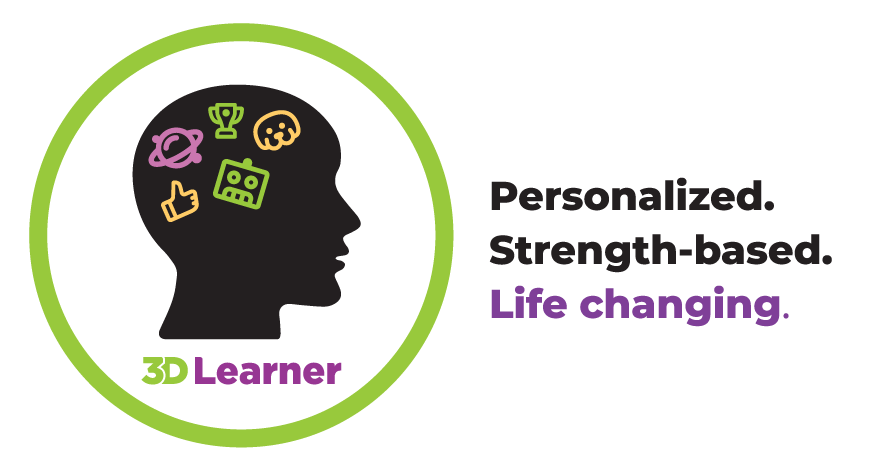
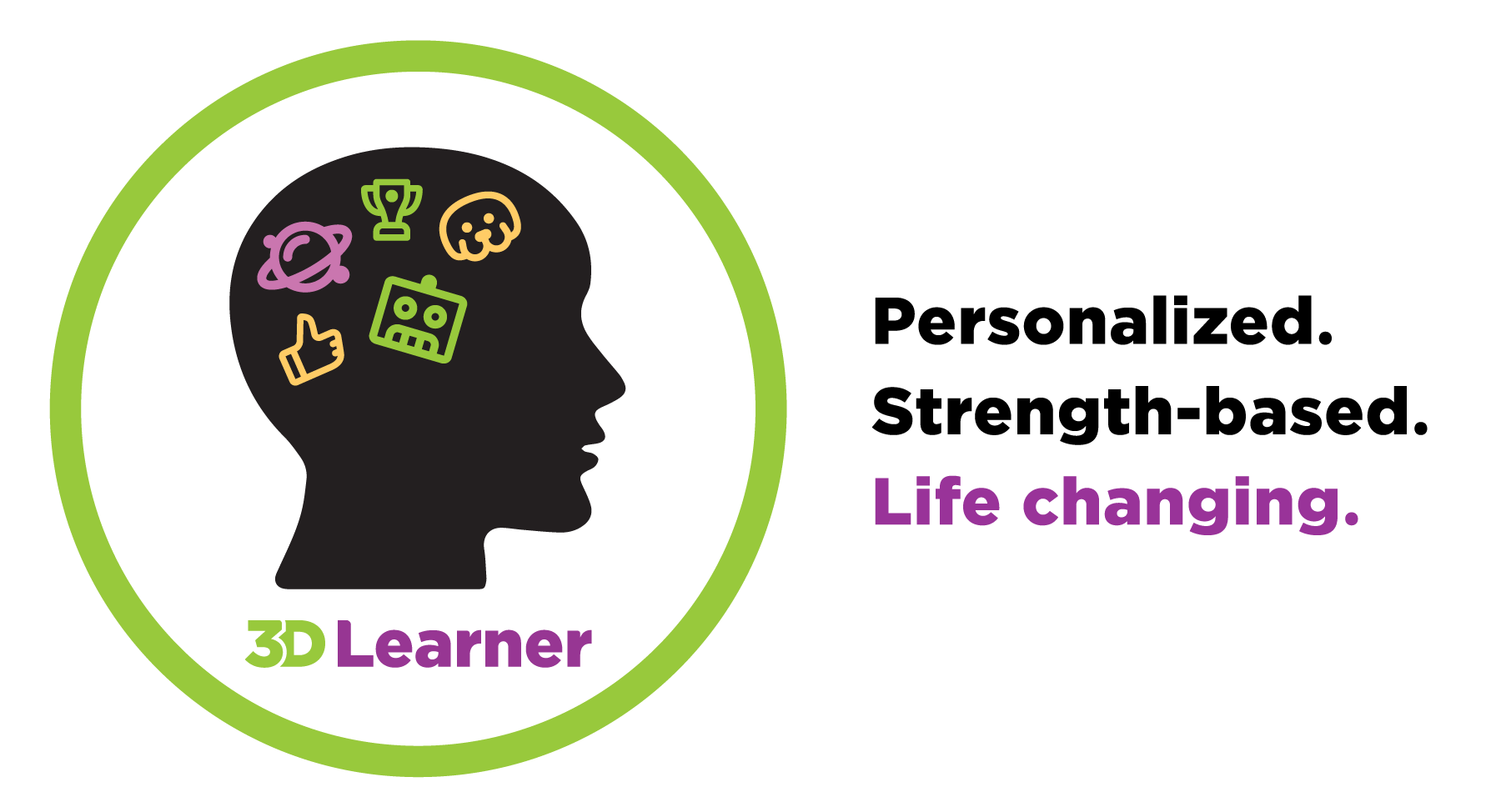






Recent Comments